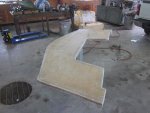Laminate both of your transom pieces together outside the boat, use your epoxy putty. Clamp or screw them together tightly, your adhesive should squeeze out of all 4 sides. After the adhesive has cured unclamp and install in the boat using you epoxy adhesive troweled to the wood and hull, clamp tightly. Again, your adhesive should squeeze out of all 4 sides. You can't overclamp or oversqueeze the transom wood to the hull, the tighter the better. Not clamping tight enough can create voids and air pockets that will reduce the bond.
Study some of the other transom and stringer installations in the different resto threads here before you start to give yourself a good idea of what you need to do.




















